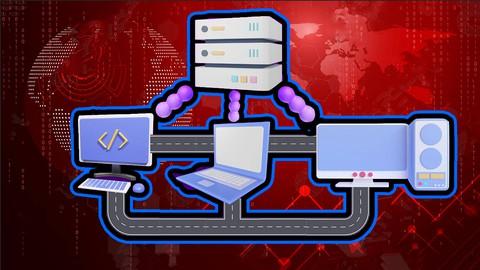Last Updated on May 13, 2024 by GeeksGod
Course : Java Network Programming – Mastering TCP/IP : CJNP+ 2024 JVA
*Get the Official Certificate after Completing the Course
Learn Java network programming by practical example applications,You will develop ClientServer,GUI Chat and other apps
Networking supplements a lot of power to simple programs. With networks, a single program can regain information stored in millions of computers positioned anywhere in the world. Java is the leading programming language composed from scratch with networking in mind. Java Networking is a notion of combining two or more computing devices together to share resources.
The first section of our udemy course introduces the essential network terminology and concepts. The networking support that Java provides is illustrated with brief examples. A simple client/server application is presented along with a threaded version of the server. We will also cover in our udemy course how nodes on a network use addresses. How Java represents these addresses is introduced along with support for IPv4 and IPv6.
This section of our udemy course also covers how Java can configure various network properties. NIO Support for Networking, explains how the NIO package provides support for communication using buffers and channels. These techniques are illustrated with a client/server application. The support that NIO provides for
asynchronous communication is also demonstrated.
We will also cover in our udemy course how HTTP is an important and widely-used protocol. Java provides support for this protocol in a variety of ways.
These techniques are illustrated along with a demonstration of how cookies are handled in Java. We will also cover in our udemy course how peer-to-peer networks provide a flexible alternative to the traditional client/server architecture. The basic peer-to-peer concepts are introduced along with demonstrations of how Java supports this architecture. FreePastry is used to illustrate one open source peer-to-peer solution framework.
We will discuss about UDP and Multicasting and how it provides provides a less reliable but more efficient way for applications to communicate across the Internet. Java’s extensive support for this protocol is demonstrated, including NIO support, and how UDP can support streaming media. We will also cover in our udemy course Network Scalability, I will explain how, as more demands are placed on a server, systems need to scale to address these demands. Several threading techniques supporting this need are demonstrated, including thread pools, futures, and the NIO’s selector. We will also cover in our udemy course Network Security, you’ll learn how applications need to protect against a variety of threats. This is supported in Java using encryption and secure hashing techniques. Symmetric and asymmetric encryption techniques are illustrated. In addition, the use of TLS/SSL is demonstrated. We will also cover in our udemy course covers how Java applications may need to exchange information with other applications that are written in different languages. The issues that impact an application’s interoperability are examined, including byte order. Communication between different implementations is demonstrated using sockets and middleware.
All the Java program communications over the network are done at the application layer. The java . net package of the J2SE APIs comprises various classes and interfaces that execute the low-level communication features, enabling the user to formulate programs that focus on resolving the problem. The Java platform is highly regarded in part because of its suitability for writing programs that use and interact with the resources on the Internet and the World Wide Web(WWW). In fact, Java-compatible browsers use this ability of the Java platform to the extreme to transport and run applets over the Internet.
Java is a premier language for network programming. java . net package encapsulate large number of classes and interface that provides an easy-to use means to access network resources. Here are some important classes and interfaces of java . net package.
Socket is the foundation of modern networking, a socket allows single computer to serve many different clients at once. Socket establishes connection through the use of port, which is a numbered socket on a particular machine. Socket communication takes place via a protocol. Socket provides a communication mechanism between two computers using TCP . There are two kinds of TCP sockets in Java. One is for server and the other is for client.














